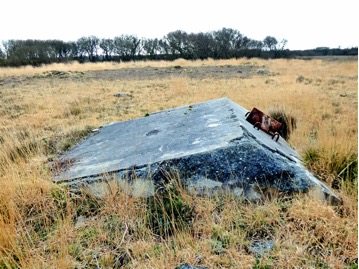Archaeology, like modern art, may have boundaries. Largely undefined, they shift as necessary. The Second World War, ruinously present on the Lizard, falls within the remit of both. Anti tank walls and blockhouses slowly become lumps in an erosive sea.

A chambered tomb1 and anchor blocks of long gone radar antennae seem determined to contest each others’ longevity on Crousa Downs. Now there are photographs of artefacts under construction and recordings of their builders, but a gifted archaeologist can still tease a gripping tale from the missing bits.

We are fortunate on The Lizard in many ways. For varied reasons it has captured the attention of diarists, authors and surveyors since well before Domesday. The most recent I quote, Oliver Rackham, died only last year. The mundane title of his ‘History of the Countryside’ dabbles in the herepath2 on the borders of St Keverne & St Anthony, Cadgwith’s hollow way, the Great Elm of Rosuic and half a dozen Saxon charters.
His source must have been the 1086 Domesday when mentioning 22 untamed mares on Goonhilly Downs which, he suggests, were the ancestresses of the Goonhilly ponies mentioned in later centuries.
Paul Foot in his Droll Teller’s Dream dredges up a mention of their lineage in Elizabeth I’s time, and at a vaguely defined 30 years’ hence a reference to their inability to haul sand to the fields – a task best performed at negligible speed by immensely powerful oxen. Instead they were mounts for the Loyal Meneage Volunteer Cavalry, grumpily ridden by undernourished locals.
Googol (named by inventors whose spelling was lax) provides the suggestion that the unit, and presumably the ponies’ descendants, were still to be reckoned with 400 years later:-
Loyal Meneage Volunteer Cavalry. James Plomer, Esq. to be Captain. Dated December 19, 1811. George Borlase, Gent, to be Lieutenant. Dated : May 21, 1812, William R. Hill, Gent, to be Cornet. Dated January 10, 1812.
The Cornishman of March 6, 1884 describes Lord Falmouth gifting an Arab stallion to John Williams of Lanarth, to be set free on Goonhilly.
The Devon & Exeter Daily Gazette of Jan 14th, 1889 suggested the breed had never crossed satisfactorily with thoroughbred sires, the offspring proving “a weedy trashy race, too light for the general purpose of riding or driving.”
The Goonhilly ponies became extinct in the early 20th century. If anyone can describe the fate of the Loyal Meneage Volunteer Cavalry another piece could be inserted in this puzzle of the past.
Lizard National Nature Reserve is currently grazed by Shetland & Dartmoor ponies who fulfil this function of their more local predecessors. As far as I am aware they do not attempt sanding or bearing their wardens into battle.
1 The 3 Brothers of Grugath near Zoar Garage
2 Saxon name for a military road
Published: Mar 2017
Author: Chris Harris, Meneage Archaeological Group
